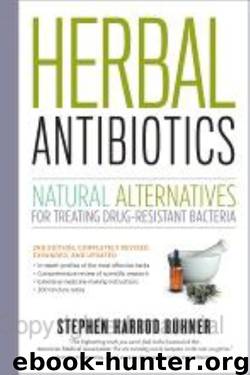Herbal Antibiotics, 2nd Edition: Natural Alternatives for Treating Drug-Resistant Bacteria by Stephen Harrod Buhner

Author:Stephen Harrod Buhner [Buhner, Stephen Harrod]
Language: eng
Format: epub
ISBN: 9781603429870
Amazon: 1603429875
Publisher: Storey Publishing, LLC
Published: 2012-07-17T04:00:00+00:00
Plant Chemistry
Eleutherosides A through M, ciwujianosides, eleutherans, isofraxidin, friedelin, beta-sitosterol, daucosterol, ethylgalactoside, chlorogenic acid, rosmarinic acid, and so on. A lot of people think the eleutherosides are the important adaptogenic and immune constituents, especially eleutheroside B and perhaps E.
Chlorogenic acid is a fairly strong antioxidant and antihyperglycemic with antiviral, antibacterial, and antifungal actions. It slows the movement of glucose into the blood. Rosmarinic acid is also potently antioxidant and anti-inflammatory, with antiviral and antibacterial actions as well.
Eleutheroside B content in the bark of the woody stems (400 mg/100 gm) is nearly four times that of the roots; eleutheroside E content, however (30 mg/100 gm), is only about one-third that of the roots. The fruits have about the same eleutheroside E content as the stem bark but only about one-tenth the eleutheroside B content. The stem bark (850 mg/100 gm) has 50 percent more chlorogenic acid than the roots but half the rosmarinic acid (11 mg/100 gm). The fruits have half as much chlorogenic acid but eight times the rosmarinic acid as the stem bark. The fruits are high in rutoside (150 mg/100 gm), the stem bark not so much (66 mg/100 gm).
Download
This site does not store any files on its server. We only index and link to content provided by other sites. Please contact the content providers to delete copyright contents if any and email us, we'll remove relevant links or contents immediately.
The Art of Coaching by Elena Aguilar(52249)
Thinking, Fast and Slow by Kahneman Daniel(11839)
The Art of Thinking Clearly by Rolf Dobelli(9951)
The 5 Love Languages: The Secret to Love That Lasts by Gary Chapman(9317)
Mindhunter: Inside the FBI's Elite Serial Crime Unit by John E. Douglas & Mark Olshaker(8751)
When Breath Becomes Air by Paul Kalanithi(8069)
Periodization Training for Sports by Tudor Bompa(7947)
Becoming Supernatural by Dr. Joe Dispenza(7869)
Turbulence by E. J. Noyes(7733)
Bodyweight Strength Training by Jay Cardiello(7686)
Therapeutic Modalities for Musculoskeletal Injuries, 4E by Craig R. Denegar & Ethan Saliba & Susan Saliba(7607)
The Road Less Traveled by M. Scott Peck(7301)
Nudge - Improving Decisions about Health, Wealth, and Happiness by Thaler Sunstein(7273)
Mastermind: How to Think Like Sherlock Holmes by Maria Konnikova(6956)
Enlightenment Now: The Case for Reason, Science, Humanism, and Progress by Steven Pinker(6891)
Win Bigly by Scott Adams(6846)
Kaplan MCAT General Chemistry Review by Kaplan(6629)
Why We Sleep: Unlocking the Power of Sleep and Dreams by Matthew Walker(6391)
The Way of Zen by Alan W. Watts(6305)
